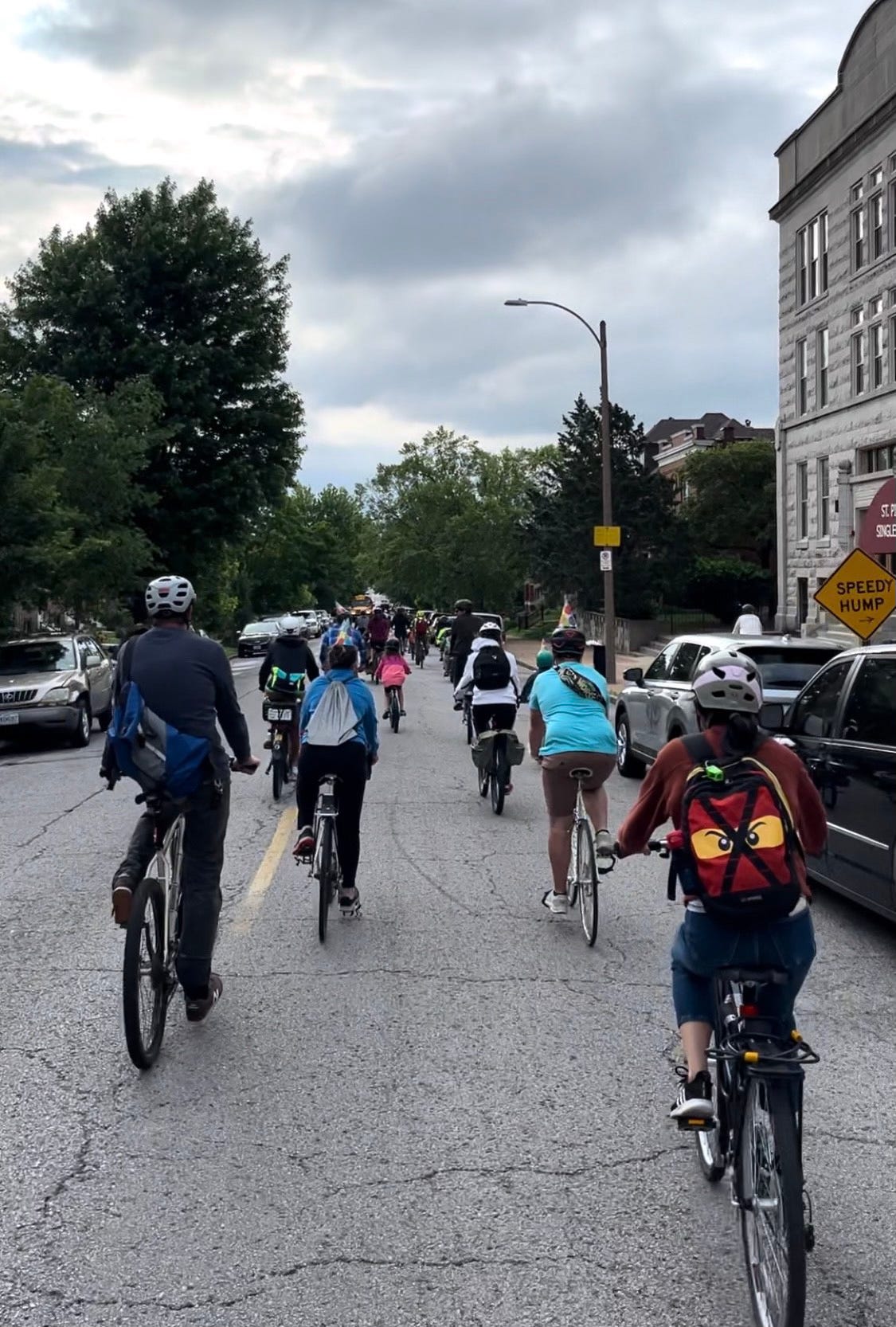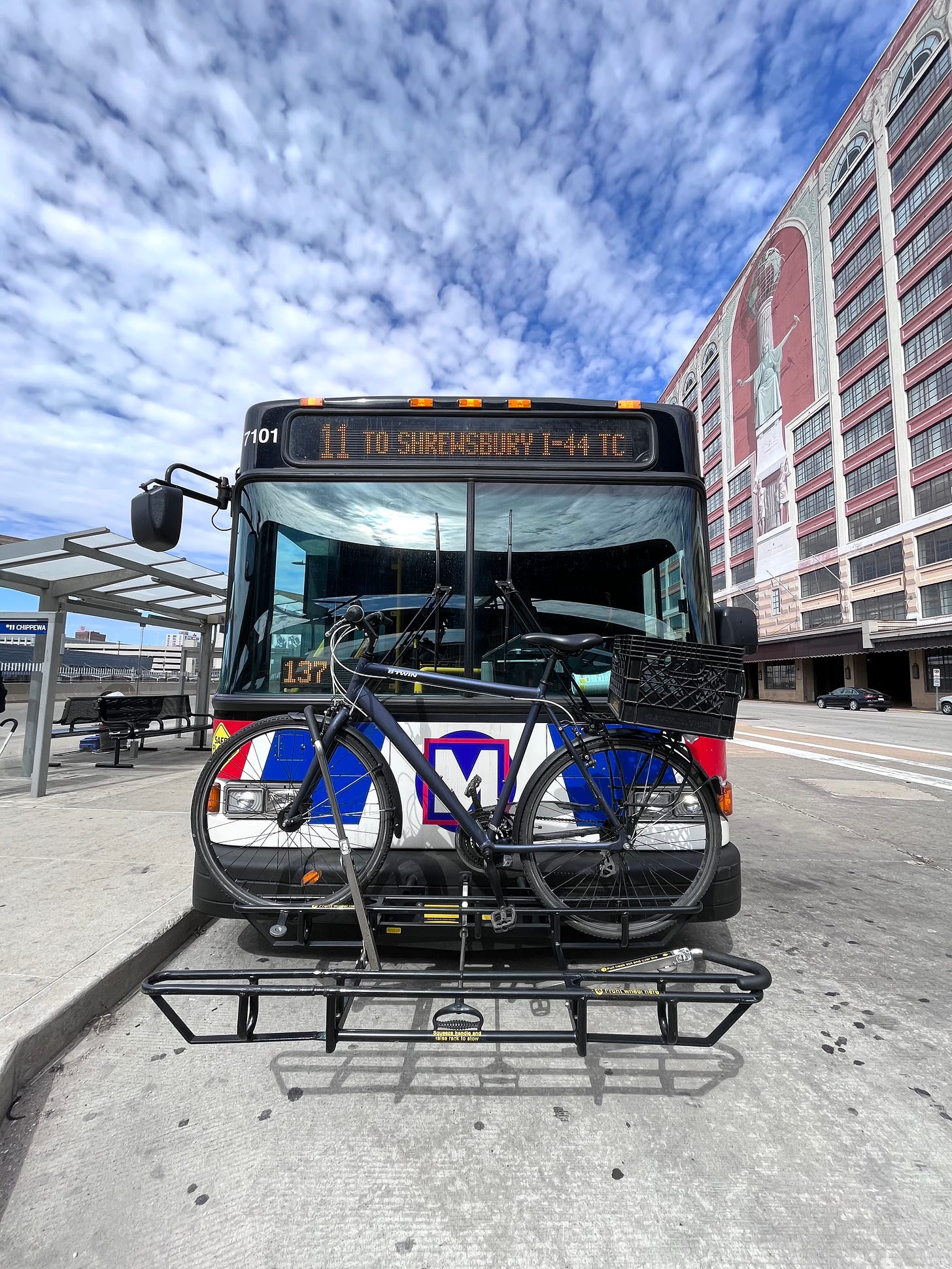People Walking, Biking, Busing Count—We Should Count Them (Literally)
Why Crash Statistics are Inadequate for Planning Safer Streets
In May 2024, Chicago's Department of Transportation claimed that biking had doubled in that city over the past five years. If biking doubled in my hometown, St. Louis, we may never know it.
Measuring modal share—the proportion of people walking/rolling, biking, taking public transit, and driving—will help determine whether car-dominant planning continues to supplant overall health and safety. With a new Complete Streets bill on the books in St. Louis, these metrics could help assess return-on-investment for new infrastructure meant to serve every road user, regardless of their means of travel.
Car crashes killed 149 people and injured 14,894 on the streets of St. Louis City and County in 2023, as collated by Trailnet (it's important to note that crashes are severely undercounted). Right now, this is our primary measuring stick: crashes that kill people.
Yet the systemic threat remains undefined. Or even named. Violence resulting from reckless driving and hostile infrastructure is euphemistically referred to as "traffic violence." Because crash statistics require automobiles, they can only truly measure the harmfulness of a dogma that prioritizes the speed and capacity of cars over all else. As Killed by a Traffic Engineer author Wes Marshall points out, police conduct crash reports seeking whom to blame, not how to improve safety.
Even Vision Zero has been warped into sugarcoating the root problem in towns like Brentwood, Missouri, that have claimed to achieve it, not because their streets are safer, but because they are so dangerous that no one dares to traverse it outside of a car.
We need metrics that keep us accountable and crash data alone is inadequate in implementing serious, sweeping change.
How do we measure whether our streets are safe, healthy, equitable?
"I'm more interested in short trips, like how are people doing their activities of daily living?" Cindy Mense, Trailnet's CEO told me, “Because those are also the most polluting."1 Mense admitted that she doesn't know how we best evaluate the health of a street grid that supports people using a variety of modes, but she agrees that we need better targets and has ideas on where to begin. "For me, the easiest place to start is...with schools, because that's 30% of traffic congestion, people dropping their kids off at school."
Demonstrating an increase of people walking, biking, and taking transit (road users that have a lower carbon footprint) makes federal funding accessible through the Congestion Mitigation Air Quality program.2 The soon-to-be Tower Grove Connector between Tower Grove Park and the Cortex Metrolink station is CMAQ-funded. If we could measure modal share citywide, Mense concluded, we could fund more multi-modal infrastructure.
We do have modal share data for work commutes collected by the United States Census Bureau. But respondents only refer to how they got to work "last week"; obfuscated is the larger story of how people move to access grocery stores, coffee shops, concerts, healthcare, parks. According to national statistics from the Bureau of Transportation, only 15 percent of trips are commutes.3
When I asked Great Rivers Greenway how they measure the success of their projects, I found that we already have a microcosmic model for counting travelers without cars.
Emma Klues, Vice President of Communications and Outreach at GRG sent me a long list of metrics that center public engagement. First on that list: how much are the trails being used? Cyclists and pedestrians made 2.88 million trips on the Greenways in 2023, according to eco-counters, devices that use infrared sensors to determine how many trips are made walking, or, if metal is present, cycling. (An eco-counter will also be installed along the Tower Grove Connector.)
Though Klues said that there's no data on counts leading specifically to funding, GRG uses the power of counts when seeking grants and donations.
The eco-counter data serves to back up community input, as exemplified by the connection of the Spencer Creek Trail in St. Charles to the Centennial Greenway expansion. As Klues explained, "Before the greenway connection? 23,000 visits in 2022. After? 48,000 visits in 2023. 109% increase in visits."
Imagine if we could claim that cycling or walking on Grand Avenue increased as much, because it was safe and functional for everyone. We need leadership that wants this. Wes Marshall again: "The overall research suggests that, on average, a 1 percent rise in transit mode share equates to a nearly 3 percent drop in traffic deaths per population."
A concerted effort to record how travelers "vote" over time is a commitment to equitable and transparent community engagement that undergirds open houses and surveys.
Let's measure the economic impact of cycle infrastructure. Let's look, as Mense recommended, at the Housing and Transportation Affordability Index to better understand how land use impacts transportation needs. Mode share is just one metric in a kaleidoscope. It's a good one, because any claim that sustainable modes of transit are on the rise is a win. In fact, it’s necessary.

According to the Environmental Protection Agency, car trips of under a mile add up to about 10 billion miles per year in the United States. If we replaced half of these trips with sustainable modes of transport, the EPA suggests, it would be the equivalent of taking 400,000 cars off of the road every year and save nearly $900 million dollars. Our streets would be safer, our air quality better, our communities healthier.
This funding can be acquired by State Departments of Transportation and metropolitan planning organizations (MPOs), like East-West Gateway, who must measure modal share and then set targets.
This number is from 2017, before work-from-home became the second highest commute mode, after driving alone, in St. Louis.






This piece was re-posted on StreetsBlog (with some excellent additional photos) and you can view it here: https://usa.streetsblog.org/2024/08/07/people-walking-biking-busing-count-and-we-should-count-them-literally
This piece was cross-posted on NextSTL and you can access it here: https://nextstl.com/2024/08/why-crash-statistics-are-inadequate-for-planning-safer-streets/